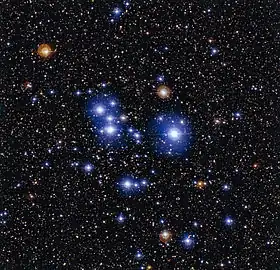Messier 47
Messier 47 (M47 or NGC 2422) is an open cluster in the mildly southern constellation of Puppis. It was discovered by Giovanni Batista Hodierna before 1654 and in his then keynote work re-discovered by Charles Messier on 1771.[lower-alpha 1] Due to his mis-recording it was independently discovered again, under the current name NGC 2422.
| Messier 47 | |
|---|---|
 | |
| Observation data (J2000.0 epoch) | |
| Right ascension | 07h 36.6m [1] |
| Declination | −14° 30′[1] |
| Distance | 498 pc[1] |
| Apparent magnitude (V) | 4.2 |
| Apparent dimensions (V) | 30.0′ |
| Physical characteristics | |
| Mass | 453[1] M☉ |
| Radius | 10.61 pc[1] |
| Estimated age | 78 million years |
| Other designations | NGC 2422, Cr 152 |
There is no cluster in the position indicated by Messier, which he expressed in terms of its right ascension and declination with respect to the star 2 Puppis. However, if the signs (+ and −) he wrote are swapped, the position matches.[2] Until this equivalency was found, M47 was considered a lost Messier Object. This identification as the same thing (ad idem) only came in 1959 with a realization by Canadian astronomer T. F. Morris.[3]
M47 is centered about 1,600 light-years away and is about 78 million years old. The member stars have been measured down to about red dwarfs at apparent magnitude 19. There are around 500 members,[1] the brightest being HD 60855, a magnitude 5.7 Be star. The cluster is dominated by hot class B main sequence and giant stars, but a noticeable colour contrast comes from its brightest red giants.[3]
It about a degree from Messier 46, which is much older and much further away.[3]
References and footnotes
- Prisinzano, L; Micela, G; Sciortino, S; Favata, F (2003). "Luminosity and Mass Function of the Galactic open cluster NGC 2422". Astronomy & Astrophysics. 404 (3): 927–938. arXiv:astro-ph/0304321. Bibcode:2003A&A...404..927P. doi:10.1051/0004-6361:20030524.
- Houston, Walter Scott (2005). Deep-Sky Wonders. Sky Publishing Corporation. ISBN 978-1-931559-23-2.
- "The hot blue stars of messier 47". ScienceDaily. 17 December 2014.
- on February 19
External links
 Media related to Messier 47 at Wikimedia Commons
Media related to Messier 47 at Wikimedia Commons- Messier 47, SEDS Messier pages
- Messier 47 Amateur Image - Waid Observatory
- Messier 47 on WikiSky: DSS2, SDSS, GALEX, IRAS, Hydrogen α, X-Ray, Astrophoto, Sky Map, Articles and images
